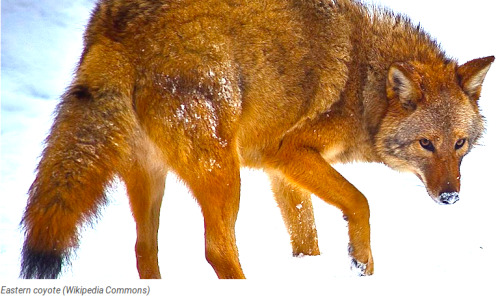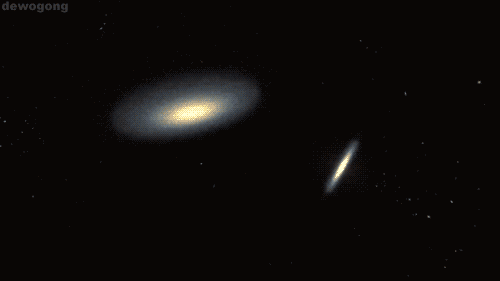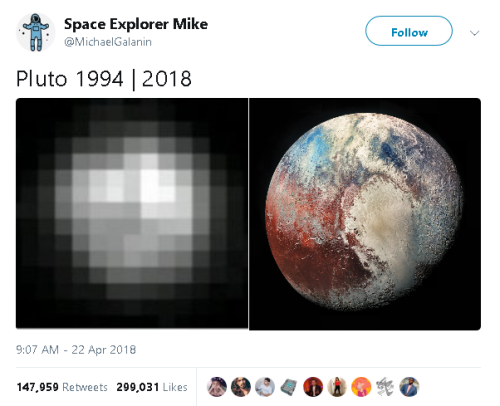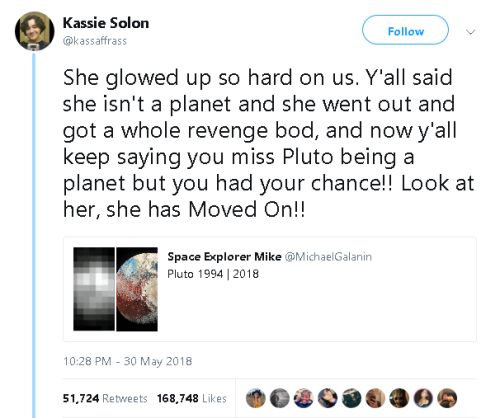That’s Not The Case At All With The Wolf-coyote-dog Hybrid, Which Has Developed Into A Sum Greater


A new species is evolving before scientists’ eyes in the eastern United States.
Wolves faced with a diminishing number of potential mates are lowering their standards and mating with other, similar species, reported The Economist.
The interbreeding began up to 200 years ago, as European settlers pushed into southern Ontario and cleared the animal’s habitat for farming and killed a large number of the wolves that lived there.
That also allowed coyotes to spread from the prairies, and the white farmers brought dogs into the region.
Over time, wolves began mating with their new, genetically similar neighbors.
The resulting offspring — which has been called the eastern coyote or, to some, the “coywolf” — now number in the millions, according to researchers at North Carolina State University.
Interspecies-bred animals are typically less vigorous than their parents, The Economist reported — if the offspring survive at all.
That’s not the case at all with the wolf-coyote-dog hybrid, which has developed into a sum greater than the whole of its parts.
At about 55 pounds, the hybrid animal is about twice as heavy as a standard coyote, and her large jaws, faster legs and muscular body allow her to take down small deer and even hunt moose in packs, and the animal is skilled at hunting in both open terrain and dense woodland.
An analysis of 437 hybrid animals found that coyote DNA dominates her genetic makeup, with about one-tenth of its DNA from dogs, usually larger dogs such as Doberman pinschers and German shepherds, and a quarter from wolves.
The animal’s cry starts out as a deep-pitched wolf howl that morphs into higher-pitched yipping — like a coyote.
Her dog DNA may carry an additional advantage.
Some scientists think the hybrid animal is able to adapt to city life — which neither coyotes or wolves have managed to do on their own — because her dog ancestry allows her to tolerate people and noise.
The coywolves have spread into some of the nation’s largest cities — including New York, Boston and Washington — using railway corridors.
The interbreeding allows the animal to diversify her diet and eat discarded food, along with rodents and smaller mammals — including cats, which coywolves eat skull and all — and they have evolved to become nocturnal to avoid humans.
The animals are also smart enough to learn to look both ways before crossing roads.
Not all researchers agree the animal is a distinct species, arguing that one species does not interbreed with another — although the hybrid’s existence raises the question of whether wolves and coyotes are distinct species in the first place.
But scientists who have studied the animal say the mixing of genes has been much faster, extensive and transformational than anyone had noticed until fairly recently.
“(This) amazing contemporary evolution story (is) happening right underneath our nose,” said Roland Kays, a researcher at North Carolina State.
Watch this report on coywolves.
Raw Story
More Posts from Science-is-magical and Others

From vision to hand action
Our hands are highly developed grasping organs that are in continuous use. Long before we stir our first cup of coffee in the morning, our hands have executed a multitude of grasps. Directing a pen between our thumb and index finger over a piece of paper with absolute precision appears as easy as catching a ball or operating a doorknob. The neuroscientists Stefan Schaffelhofer and Hansjörg Scherberger of the German Primate Center (DPZ) have studied how the brain controls the different grasping movements. In their research with rhesus macaques, it was found that the three brain areas AIP, F5 and M1 that are responsible for planning and executing hand movements, perform different tasks within their neural network. The AIP area is mainly responsible for processing visual features of objects, such as their size and shape. This optical information is translated into motor commands in the F5 area. The M1 area is ultimately responsible for turning this motor commands into actions. The results of the study contribute to the development of neuroprosthetics that should help paralyzed patients to regain their hand functions (eLife, 2016).
The three brain areas AIP, F5 and M1 lay in the cerebral cortex and form a neural network responsible for translating visual properties of an object into a corresponding hand movement. Until now, the details of how this “visuomotor transformation” are performed have been unclear. During the course of his PhD thesis at the German Primate Center, neuroscientist Stefan Schaffelhofer intensively studied the neural mechanisms that control grasping movements. “We wanted to find out how and where visual information about grasped objects, for example their shape or size, and motor characteristics of the hand, like the strength and type of a grip, are processed in the different grasp-related areas of the brain”, says Schaffelhofer.
For this, two rhesus macaques were trained to repeatedly grasp 50 different objects. At the same time, the activity of hundreds of nerve cells was measured with so-called microelectrode arrays. In order to compare the applied grip types with the neural signals, the monkeys wore an electromagnetic data glove that recorded all the finger and hand movements. The experimental setup was designed to individually observe the phases of the visuomotor transformation in the brain, namely the processing of visual object properties, the motion planning and execution. For this, the scientists developed a delayed grasping task. In order for the monkey to see the object, it was briefly lit before the start of the grasping movement. The subsequent movement took place in the dark with a short delay. In this way, visual and motor signals of neurons could be examined separately.
The results show that the AIP area is primarily responsible for the processing of visual object features. “The neurons mainly respond to the three-dimensional shape of different objects”, says Stefan Schaffelhofer. “Due to the different activity of the neurons, we could precisely distinguish as to whether the monkeys had seen a sphere, cube or cylinder. Even abstract object shapes could be differentiated based on the observed cell activity.”
In contrast to AIP, area F5 and M1 did not represent object geometries, but the corresponding hand configurations used to grasp the objects. The information of F5 and M1 neurons indicated a strong resemblance to the hand movements recorded with the data glove. “In our study we were able to show where and how visual properties of objects are converted into corresponding movement commands”, says Stefan Schaffelhofer. “In this process, the F5 area plays a central role in visuomotor transformation. Its neurons receive direct visual object information from AIP and can translate the signals into motor plans that are then executed in M1. Thus, area F5 has contact to both, the visual and motor part of the brain.”
Knowledge of how to control grasp movements is essential for the development of neuronal hand prosthetics. “In paraplegic patients, the connection between the brain and limbs is no longer functional. Neural interfaces can replace this functionality”, says Hansjörg Scherberger, head of the Neurobiology Laboratory at the DPZ. “They can read the motor signals in the brain and use them for prosthetic control. In order to program these interfaces properly, it is crucial to know how and where our brain controls the grasping movements”. The findings of this study will facilitate to new neuroprosthetic applications that can selectively process the areas’ individual information in order to improve their usability and accuracy.

Physicists Detect Gravitational Waves, Proving Einstein Right
On Thursday (Feb. 11, 2016) at 10:30 a.m. ET, the National Science Foundation will gather scientists from Caltech, MIT and the LIGO Scientific Collaboration in Washington D.C. to update the scientific community on the efforts being made by the Laser Interferometer Gravitational-wave Observatory (LIGO) to detect gravitational waves.
But why is this exciting? And what the heck are “gravitational waves”?
Keep reading
A puzzling expected value
Pick a (uniformly) random real number from the unit interval [0,1] and repeat this until the sum of all chosen numbers exceeds 1. What is the expected number of real values you will pick?
The quite surprising answer is Eulers constant, e ≈ 2.71828.
A demonstration can be found on Wolfram MathWorld.
Today is Copernicus’s 540th birthday. You may remember Copernicus as the man who said “Hey, what if the Earth went around the sun?” To which the Catholic Church replied “Hey, what if we set you on fire?”
Blowing Bubbles in the Gamma-ray Sky

Did you know our Milky Way galaxy is blowing bubbles? Two of them, each 25,000 light-years tall! They extend above and below the disk of the galaxy, like the two halves of an hourglass. We can’t see them with our own eyes because they’re only apparent in gamma-ray light, the highest-energy light in the universe.

We didn’t even know these humongous structures were smack in the middle of our galaxy until 2010. Scientists found them when they analyzed the first two years of data from NASA’s Fermi Gamma-ray Space Telescope. They dubbed them the “Fermi bubbles” and found that in addition to being really big and spread out, they seem to have well-defined edges. The bubbles’ shape and the light they give off led scientists to think they were created by a rapid release of energy. But by what? And when?

One possible explanation is that they could be leftovers from the last big meal eaten by the supermassive black hole at the center of our galaxy. This monster is more than 4 million times the mass of our own Sun. Scientists think it may have slurped up a big cloud of hydrogen between 6 and 9 million years ago and then burped jets of hot gas that we see in gamma rays and X-rays.

Another possible explanation is that the bubbles could be the remains of star formation. There are massive clusters of stars at very the center of the Milky Way — sometimes the stars are so closely packed they’re a million times more dense than in the outer suburb of the galaxy where we live. If there was a burst of star formation in this area a few million years ago, it could have created the surge of gas needed to in turn create the Fermi bubbles.

It took us until 2010 to see these Fermi bubbles because the sky is filled with a fog of other gamma rays that can obscure our view. This fog is created when particles moving near light speed bump into gas, dust, and light in the Milky Way. These collisions produce gamma rays, and scientists had to factor out the fog to unveil the bubbles.

Scientists continue to study the possible causes of these massive bubbles using the 10 years of data Fermi has collected so far. Fermi has also made many other exciting discoveries — like the the collision of superdense neutron stars and the nature of space-time. Learn more about Fermi and how we’ve been celebrating its first decade in space.
Make sure to follow us on Tumblr for your regular dose of space: http://nasa.tumblr.com

It often seems so quiet after a snowfall because the fresh powder absorbs sound waves. As the snow melts and freezes, it then creates a reflective surface that allows sound to travel farther than normal. Source
-
 bajiion liked this · 2 months ago
bajiion liked this · 2 months ago -
 supersciencegeek liked this · 2 months ago
supersciencegeek liked this · 2 months ago -
 yenoodlethings reblogged this · 2 months ago
yenoodlethings reblogged this · 2 months ago -
 pan-left-close-on-the-steeple liked this · 3 months ago
pan-left-close-on-the-steeple liked this · 3 months ago -
 malcanine liked this · 5 months ago
malcanine liked this · 5 months ago -
 leftemperor liked this · 6 months ago
leftemperor liked this · 6 months ago -
 daschantal05 liked this · 6 months ago
daschantal05 liked this · 6 months ago -
 l0r3n1 liked this · 6 months ago
l0r3n1 liked this · 6 months ago -
 leudani99 liked this · 6 months ago
leudani99 liked this · 6 months ago -
 moondeer1616 reblogged this · 6 months ago
moondeer1616 reblogged this · 6 months ago -
 moondeer1616 liked this · 6 months ago
moondeer1616 liked this · 6 months ago -
 here-and-genderqueer liked this · 6 months ago
here-and-genderqueer liked this · 6 months ago -
 dapperdann204 reblogged this · 6 months ago
dapperdann204 reblogged this · 6 months ago -
 dapperdann204 liked this · 6 months ago
dapperdann204 liked this · 6 months ago -
 sad-radio liked this · 6 months ago
sad-radio liked this · 6 months ago -
 hamstrous liked this · 6 months ago
hamstrous liked this · 6 months ago -
 covesdadappreciation liked this · 7 months ago
covesdadappreciation liked this · 7 months ago -
 mortuusdiebus liked this · 7 months ago
mortuusdiebus liked this · 7 months ago -
 astersandbees reblogged this · 7 months ago
astersandbees reblogged this · 7 months ago -
 astersandbees liked this · 7 months ago
astersandbees liked this · 7 months ago -
 pitofrats reblogged this · 7 months ago
pitofrats reblogged this · 7 months ago -
 usernameusernameusernameuse reblogged this · 7 months ago
usernameusernameusernameuse reblogged this · 7 months ago -
 usernameusernameusernameuse liked this · 7 months ago
usernameusernameusernameuse liked this · 7 months ago -
 fenixfoxtrot510 reblogged this · 7 months ago
fenixfoxtrot510 reblogged this · 7 months ago -
 fenixfoxtrot510 liked this · 7 months ago
fenixfoxtrot510 liked this · 7 months ago -
 nightthewing reblogged this · 7 months ago
nightthewing reblogged this · 7 months ago -
 nightthewing liked this · 7 months ago
nightthewing liked this · 7 months ago -
 kitkaedatidler reblogged this · 7 months ago
kitkaedatidler reblogged this · 7 months ago -
 dreaming-of-books-and-places reblogged this · 7 months ago
dreaming-of-books-and-places reblogged this · 7 months ago -
 dreaming-of-books-and-places liked this · 7 months ago
dreaming-of-books-and-places liked this · 7 months ago -
 steampoweredskeleton liked this · 7 months ago
steampoweredskeleton liked this · 7 months ago -
 kelpasaur reblogged this · 7 months ago
kelpasaur reblogged this · 7 months ago -
 crim-bat reblogged this · 7 months ago
crim-bat reblogged this · 7 months ago -
 ladybites liked this · 7 months ago
ladybites liked this · 7 months ago -
 hedgehogoftime reblogged this · 7 months ago
hedgehogoftime reblogged this · 7 months ago -
 fablenaught reblogged this · 7 months ago
fablenaught reblogged this · 7 months ago -
 beastkaiju liked this · 7 months ago
beastkaiju liked this · 7 months ago -
 hobbitsetal liked this · 7 months ago
hobbitsetal liked this · 7 months ago -
 katharkness reblogged this · 7 months ago
katharkness reblogged this · 7 months ago -
 katharkness liked this · 7 months ago
katharkness liked this · 7 months ago -
 vulchak liked this · 7 months ago
vulchak liked this · 7 months ago -
 monaiargancoconutsoy liked this · 7 months ago
monaiargancoconutsoy liked this · 7 months ago -
 defctive-e liked this · 7 months ago
defctive-e liked this · 7 months ago -
 stew-is-sus liked this · 7 months ago
stew-is-sus liked this · 7 months ago -
 mothnem reblogged this · 7 months ago
mothnem reblogged this · 7 months ago -
 sonic-fairyspell liked this · 7 months ago
sonic-fairyspell liked this · 7 months ago -
 sonic-fairyspell reblogged this · 7 months ago
sonic-fairyspell reblogged this · 7 months ago -
 roseaesynstylae reblogged this · 7 months ago
roseaesynstylae reblogged this · 7 months ago -
 kiki-miserychic reblogged this · 9 months ago
kiki-miserychic reblogged this · 9 months ago




